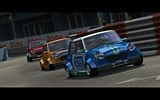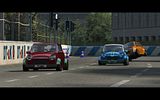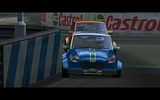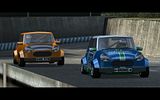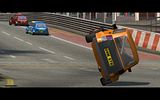Few shots of last nights racing
Nice pic!
 Love that FZ5 skin, looks great on the track.
Love that FZ5 skin, looks great on the track.This is my messy attempt at editing, it is a better view though...

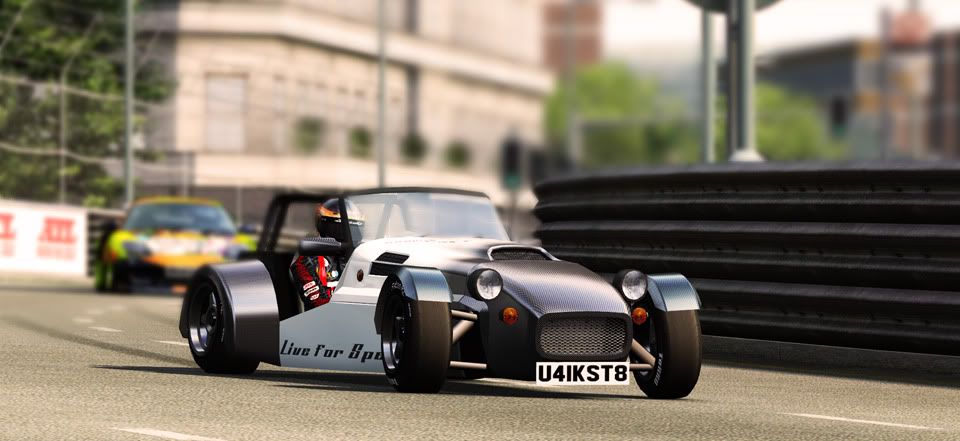
Just had a few good races with Jorge there tonight. I even managed to beat the server record( ) after tweaking the setup Jorge kindly gave me.
) after tweaking the setup Jorge kindly gave me.
Looking forward to the event, hopefully nothing comes up and I'll be able to race.
This is where sim racing is at it's best lads. Everyone on similar wheel/pedal/shifter/view setup.
Good stuff Jorge, keep it up and thanks for hosting!
 ) after tweaking the setup Jorge kindly gave me.
) after tweaking the setup Jorge kindly gave me.
Looking forward to the event, hopefully nothing comes up and I'll be able to race.

This is where sim racing is at it's best lads. Everyone on similar wheel/pedal/shifter/view setup.
Good stuff Jorge, keep it up and thanks for hosting!

z28 was before z30 so I'd imagine you'll be ok.
Great stuff, thanks Scavier!
Maybe the small black disk is spining on the motor, see pic:

My one started doing that, then the disk broke in half, I think adjusting mine weakened the plastic then it broke. I superglued the disk together and glued it to the motor, no problems since.

My one started doing that, then the disk broke in half, I think adjusting mine weakened the plastic then it broke. I superglued the disk together and glued it to the motor, no problems since.
I think I understand the KE = m v^2 equation and what it calculates. I think you lads aren't taking everything into consideration when discussing the KE of the falling debris.
Obviously they did, because they both reached terminal velocity
 . Does a grain of sand and a rock have the same aerodynamic drag? Then does a grain of sand and a rock reach terminal velocity if dropped from the same height? I don't think so.
. Does a grain of sand and a rock have the same aerodynamic drag? Then does a grain of sand and a rock reach terminal velocity if dropped from the same height? I don't think so.Exactly, you said:
So, they[the different sized pieces of debris from the tower] couldn't have the same KE because (a) they both didn't impact over the same period of time (smaller debris covered a larger area so had a longer collision time / larger debris covered a smaller area(in relation to the dust cloud of similar mass) so had a shorter collision time) and (b) they both didn't have the same impact area (smaller debris(dust cloud with a certain mass)=larger area / larger debris(with similar mass)=smaller area(in relation to the dust cloud)). And with different amounts of aerodynamic drag, they both couldn't have reached the same speed falling from the same height.
As you said, to get 10 000 000 grains of sand, weighing 2g per grain, and piece of rock weighing 20 000kg to go "as fast speed as the aerodynamic drag allow", they must be dropped from a really long height, so they reached a speed of "something around 300kmh"! So there's no chance the different sized pieces of the tower reached the same speed just falling from the similar distance as the height of the tower, which was, at the roof top, just 1450 feet (440 m), so the pieces fell roughly 3/4 that distance which is 1 087.5 feet (330m). So they couldn't possibly reach the same speed, which means the velocity wouldn't be the same for the dust particles and the large chunks of the tower, which means the results of the calculation KE = m v^2 would be different.
Now, time to go watch the Monaco GP.

You're serious aren't you? Well, all I'll say is I did make that layout, I wouldn't steal anyone's work. Show me your layout. I wont ask you to prove it's yours because I know, 100% sure, that I put the work into making that layout.

So, if the small debris(gravel sized particles) was spread out over a larger area and hit the ground, or structures below, over a longer period of time and the larger debris(large outer sections and core columns of the towers) hit the ground, or structures below, over a shorter period of time, the Impluse of the larger debris would put a greater force on the structures below, therefore doing more damage?
And, they couldn't have the same KE because (a) they both didn't impact over the same period of time (smaller debris=longer time period / larger debris=shorter time period) and (b) they both didn't have the same impact area (smaller debris=larger area / larger debris=smaller area)?
Am I understanding this right?
I'll be honest, it's tough to get my head around but I'm getting there...
I'm sure I understand the equation for KE. But you guys are only thinking of this in a controlled environment. Like in one hand you have dust or gravel and the other you have a concrete block with the exact same mass, drop them both and they should hit the ground with the same KE, am I right? But at the towers you can clearly see the larger pieces falling faster than the dust, why? Because the dust isn't being dropped exactly like a concrete block would, it's being exploded outward(whether by pancaking floors or explosives, makes no difference in this) and therefore is being dispersed into the air over a larger area which then reduces it's velocity while falling, it wouldn't hit it's highest potential speed before hitting the ground. So in my mind it couldn't possibly have the same or even close to, the same KE as a falling piece of the building.
I'm sure you'll correct me if I'm wrong.
I'm sure I understand the equation for KE. But you guys are only thinking of this in a controlled environment. Like in one hand you have dust or gravel and the other you have a concrete block with the exact same mass, drop them both and they should hit the ground with the same KE, am I right? But at the towers you can clearly see the larger pieces falling faster than the dust, why? Because the dust isn't being dropped exactly like a concrete block would, it's being exploded outward(whether by pancaking floors or explosives, makes no difference in this) and therefore is being dispersed into the air over a larger area which then reduces it's velocity while falling, it wouldn't hit it's highest potential speed before hitting the ground. So in my mind it couldn't possibly have the same or even close to, the same KE as a falling piece of the building.
I'm sure you'll correct me if I'm wrong.
Last edited by U4IK ST8, .
Yea, ok, I can imagine there would have been gravel sized particles, I hadn't noticed any, but as you can see from videos of the falling debris, the largest pieces of the towers structure are falling faster, maybe because the "dust" isn't going straight down but sideways, or laterally as you might say, so obviously it wouldn't be falling as fast. Of course in an ideal situation everything falls at the force of gravity (heh, just realised you were probably trying to catch me with that one) but in this situation, floors being crushed, core columns and other large pieces of metal falling straight down, the dust wouldn't have the impact it would if it was dropped at the exact time a piece of solid concrete with the same mass was dropped. (is that right?
 ) It's all coming down separately, not as one mass of gravel or one mass of concrete but spread out so it's impact wouldn't be as it would in an ideal situation, or a controlled enviroment.
) It's all coming down separately, not as one mass of gravel or one mass of concrete but spread out so it's impact wouldn't be as it would in an ideal situation, or a controlled enviroment.It's where I "hangout" anyway, there's a discussion going on about 9/11 so I get involved, what's wrong with that? And! the official theory is just that a theory, and a conspiracy theory at that.
Sorry you feel this way, but if you don't want to read it, you don't have to open the thread, simple.
Sorry you feel this way, but if you don't want to read it, you don't have to open the thread, simple.
Seriously? But in this equation KE= 1/2 MV^2, the velocity of the falling dust would be nowhere near the velocity of the solid concrete, right?, therefore the resulting KE would be far less, no?
I'm pretty sure that's what happened too, who said it didn't happen that way?
Respect? The people who died were killed but no one knows exactly why they were killed, I'm sure if you found out a relative of yours died in suspicious circumstances you'd want to know what happened....
You should always question authority, always, not just take what they say as truth. As I said, check Racer's posts, the 9/11 Commission itself said their conclusion on what actually happened on 9/11 was based on false information!
Last edited by U4IK ST8, .
So, in the Game Controller window, select the G25 and click Properties, then, click Settings(bottom right) and there you can change the rotation.
Well, this would be the first thing to do if nothing is working...

Well, this would be the first thing to do if nothing is working...

Last edited by U4IK ST8, .
Check all your cables because it should, at least, be recognised in the Control Panel / Game Controller window.
So you are saying falling concrete in the form of dust has the same kinectic energy as a solid piece of falling concrete? Seems you didn't read the full post, or, as usual, you just want to pick certain parts of a post to stir the sh!t... 

So I thought I'd post up my latest gymkhana style layout. I have it running on a dedi server on my pc, Gymkhana TEST LX4 only, so that means it has to go off every night, but I'll have it on most days for anyone to try, or till I get bored of it hehe. 
Added a screenshot and the layout file, also the top times as of last night so you can see what times you should be getting.
Enjoy!

EDIT: I've added the set I was using, which I originally got from [FU]Elson, so thanks to him for a good start. I edited some small things and managed to beat his time. I can see someone getting a high 1:23 with a super fast run. Good luck anyway and have fun!

Added a screenshot and the layout file, also the top times as of last night so you can see what times you should be getting.
Enjoy!

EDIT: I've added the set I was using, which I originally got from [FU]Elson, so thanks to him for a good start. I edited some small things and managed to beat his time. I can see someone getting a high 1:23 with a super fast run. Good luck anyway and have fun!

Last edited by U4IK ST8, .
Reason : Added setup
But I didn't ask you anything in there, I just stated facts, a pancake collapse = floors on top of one another, slower collapse and standing core. Where did I ask for a thorough explanation?
So, concrete smashed into dust from pancaking floors has the same strength if it wasn't crushed to dust? Really? You and the official theorists say that the floors pancaked and the force caused the floors to be crushed into all that dust. So I was saying, if all those top floors, the section above the impact zone, never broke into pieces, it would have a lot more structural strength when hitting the structures below. And, because it did break apart, it would have very little kinetic energy compared to it being a complete structure, which is true. It would have less mass, because of the pulverised concrete on every floor, therefore this "kinetic energy is equal to half of the mass of the object times the object's velocity squared" would prove my point. It wouldn't have the structural strength, therefore less mass and therefore not enough kinetic energy to crush the remaining floors of the towers completely. That's how I see it anyway.
WTC 4 was the worst damaged(pic 1), which was almost crushed completely. I'd like to draw you attention to the hotel though(pic 2), cover the right half the hotel with your hand, see the way the structure is crushed asymmetrically? That is kinda how the towers should have looked. Start on the left of the picture and imagine the tower debris falling onto it, why didn't it crush it straight down? Why did the hotel hold it's strength and not just crumble completely to the ground? Because that was the path of most resistance. The falling debris followed the path of least resistance, just like physics says it should!
@ CSU1 - Ignorant you say? Really?
Also,
You are just believing what you are told, so you don't actually know what happened imo, and even the people telling you this, the 911 Comission, have said it was based on false information, check Racer's post, but yet I'm the ignorant one because I want to find out what really happened.
And no one is bickering, we are trying to find out what really happened through discussion, to find the truth, so that the families of the people who did die on 911 will know exactly what happened! Even think of the first responders who were told that the air was fine to breathe but are now dying from asbestos poisoning! It was known to the authorities that the towers were full of asbestos but decided never to tell the people on the ground, shocking.
Prove it, the official story says otherwise, check the Pentagon... once again you have no clue what you are talking about... I suppose though, you are doing what you do best, hence the 11,000+ posts...
FGED GREDG RDFGDR GSFDG
